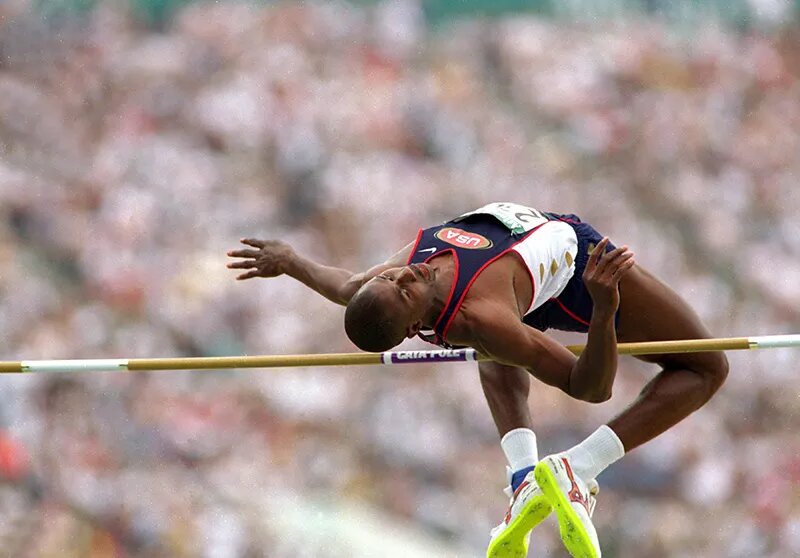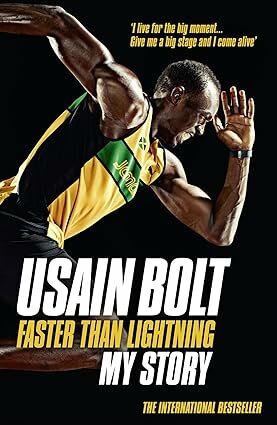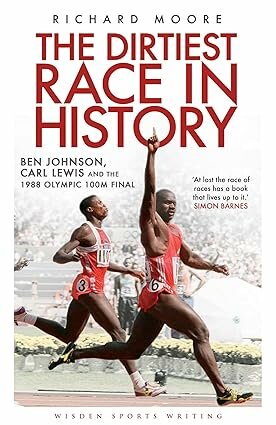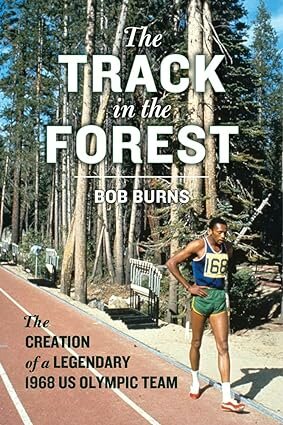Charles Austin, Journey to the Top
A 28-year unbeaten Olympic record
“I think this team we have is going to do very well,” says Charles Austin of the U.S. Track & Field squad prepping for the Paris Olympics. “It reminds me of the 1996 team, which was a monster!”
Austin was a member of that monster powerhouse- Carl Lewis, Michael Johnson, Dan O’Brien, and others- who took 23 medals (13 gold) at the 1996 Atlanta Games, more than twice the number of the next country.
At the tournaments, the native Texan shattered the Olympic record in the high-jump, leaping 7’10 (2.39 m) over the bar to bring home a gold accolade.
But what’s remarkable is that almost 3 decades on, Austin still occupies the top of the Olympic high bar pyramid. He also stands with friend and mentor, Hollis Conway, as the 2 greatest Americans in the vertical clearance event.
BUY- 'Usain Bolt: Faster Than Lightning' (1,247 ratings)
Today, the 56-year-old owns So High Sports & Fitness, a performance center located in San Marcos, Texas where he trains ordinary folks as well as professional athletes.
His patented and mobile Total Body Board machines are used by NBA and NFL teams when they are on the road.
It was an unlikely journey for the naturally-gifted athlete who played all major sports but didn’t pick up the hurdle discipline until the latter part of his senior year in high school.
“My thing wasn’t high jumping. I wanted to play basketball,“ he tells Sports History Weekly.
Austin grew up in a small town south of Houston, Texas and attended Van Vleck High, a school known to punch above its weight in athletics.
His neighbor and schoolmate, Robert Blackmon, would go on to play football at Baylor and then join the Seattle Seahawks. It was Blackmon who convinced Austin to try out for T&F.
Jumping wasn’t his interest, but with some cajoling he gave it a try. It was after basketball season with 3 months left to the school year when the coach said that if he could jump 6 feet then he would be on the team.
Wearing jeans and basketball shoes, Austin took a few steps back and easily cleared a 6-foot bar. He was only 5’10½ at the time and before the year was out, he jumped 6’11 and came 3rd in the regionals.
He had 2 scholarship offers and chose to attend Texas State University (Southwest Texas back then), which was closer to home.
But $450 a semester plus books didn’t help much and Austin, who came from a single parent household with siblings, turned to loans and Pell grants to keep himself enrolled.
“I wasn’t very happy with that scholarship and didn’t put much into high jump training.”
Still, in his freshman year he broke the school record jumping 7’½. In his sophomore year, he cleared 7’1¾ and the coach bumped him to $750 a semester, plus books.
But he was still disgruntled with the lack of financial support. “I was still bothered, since I knew other guys on the high jumping team couldn’t beat me but they were still getting full scholarships.”
After taking summer classes, he shifted his mindset and got more serious with his athletic talents. As a junior, he cleared 7’5¼ and placed 2nd at the NCAA Outdoor Championships.
Senior year in 1990 saw him overtake a Conference record at 7’8½ and then win the NCAA Championships with 7’7¾, becoming the #1 college high jumper in the country.
The experience gave him a whole new perspective on the sport. “With 7’8½, I felt I could compete with the best on the planet now.”
Gifted in strength and speed and competitively driven, it was always focus and concentration that made the difference. “For me, 90% was mental since I had the athleticism.”
Mostly self-taught and self-coached, Austin took in hours of high jump videos, absorbing the techniques of the best in the art and applying what worked optimally for his body.
Standing 6’½, he was shorter than the typical high jumper who was closer to 6’5. But he was very in tune with his physicality. “I knew my body so well that I could tell when I gained a pound.”
At the time, the world’s best in the field was Cuba’s Javier Sotomayor who still remains the only jumper to ever clear 8’. His leap of 8’¼ (2.45 m) at the Salamanca Invitational in Spain in 1993 still stands as the all-time international record.
On tape, Austin would watch Sotomayor, Sweden’s Patrik Sjoberg, and Hollis Conway, the American who won silver at the 1988 Olympics and with whom he developed a friendship.
“Hollis played a big part in the guidance that I needed…I studied everything he did from his warm up, to the way he runs, to his mindset.”
It paid off. At the 1991 World Championships in Tokyo, Austin clinched gold, Sotomayor took silver, and Conway nabbed bronze.
Shortly after, he posted an American best of 7’10¼ at the prestigious Weltklasse Zurich invitational. It was there that Conway pepped him after he jumped into the bar and told him he was going off the noisy crowd instead of focusing on his rhythm.
“If Hollis didn’t pull me off to the side, then I probably wouldn’t have figured it out.”
Austin’s first Olympics in 1992 were now approaching and he was a clear contender for a medal. But a gnawing knee injury that he sustained his senior year in college was progressively getting worse.
BUY- 'The Track in the Forest: The Creation of a Legendary 1968 Olympic Team' (69 ratings)
There were doubts whether his knee would hold. Flustered with his condition, it wasn’t until the night before the qualification round that he made up his mind to compete.
“I decided I’m going for it and if it tears up, then it is what it is…it’s the Olympics.”
He made the final and secured a spot on the team. But the mental side would prove to be his undoing in Barcelona and leave him bitter even to this day.
“I went into Barcelona with such a negative attitude and a bad mental state.”
His confidence shaken, he failed to make the podium and placed 8th overall. Sotomayor took gold, Sjoberg silver, and Conway bronze.
OUR FREE WEEKLY NEWSLETTER, OR JUST $30/YR WITH ARCHIVES, APP & AUDIO
The next few years took him to a low point in life as he faced financial hardship, physical rehabilitation, and a divorce with 2 kids.
Austin had surgery in the summer of 1993, which removed nearly half his patella tendon. 4 doctors told him the damage was too severe and he should reconsider his career.
Dejected but undeterred, he rested home and rehabilitated slowly with resistance bands, which today form the core of his exercise machines.
Meanwhile, the bills started piling up and late payment notices were coming in for his car and home. A local banker stayed close to him and kept his home from being repossessed.
Austin had only 2 years of corporate sponsorships during his jumping career, which paid $45,000 a year from Japanese companies, Mazda and Mizuno.
With time, his knee began to strengthen and in December of 1993 he took 5 steps behind a bar and cleared 6’10. In 1994, he managed 7’7¼, and in 1995 he jumped 7’8, which was the 5th highest in the world.
“In the Fall of 1995, I said to myself…I’m going to win the Olympics. My knee isn’t giving me any trouble and it’s the first time I’m healthy since 1990…nobody is gonna beat me!”
Austin and his wife divorced in January of 1996 and he moved into an apartment. The day he left for the Olympic trials his wife took the kids and relocated to Hawaii.
Laser focused on Atlanta, his sights were now on breaking a world record and not just going for gold. At the final, he missed the first two jumps at 7’9¼ and then for his 3rd and final attempt, made a risky bet of raising the bar to 7’10.
He ended up soaring over the top to realize a dream and an Olympic record, beating out Poland’s Artur Paryka (silver) and Great Britain’s Steve Smith (bronze). Sotomayor came in 12th, struggling with an ankle injury.
BUY- 'The Wizard of Foz: Dick Fosbury's One-Man High-Jump Revolution' (88 ratings)
Austin went on to win gold at the 1997 World Indoor Championships in Paris and the 1998 World Cup Championships in Johannesburg.
He was a medal contender for the 2000 Sydney Olympics, but failed to qualify at the final. At that point, aged 32, he realized his body was done and his best days were behind him.
“I was towards the end of my career and was now trying to figure out what to do.”
His entry into personal training began in 2001 when he met NBA shooting guard, John Starks, at a game. Starks was approaching the twilight of his own playing career and asked Austin if he could train him.
“I went back and forth to Oklahoma to work with John and got great results with him.”
He then worked with San Antonio Spurs’ David Robinson who would later go on to win the 2003 NBA championship.
It was the start of Austin’s next chapter in life.
In 2002, he opened an 800 sf training studio and in 2008 he launched his 12,000 sf performance center, specializing in general fitness and injury rehabilitation.
A journey of personal and athletic triumphs, Austin's story is as inspiring as it is historic. We look forward to this summer when his record will be challenged for the 7th time at the Olympics.
OUR FREE WEEKLY NEWSLETTER, OR JUST $30/YR WITH ARCHIVES, APP & AUDIO














